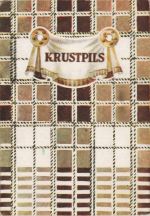This foldout features illustrations of a full women's folk costume and various details: ornamentation of the women's cape/shawl, blouse schematic, sleeve-end embroidery, collar border, blouse shoulder embroidery, brooch, separately woven shawl border, and descriptive overviews in French, English, Russian, and Latvian.
Krustpils
Today's Krustpils district was already settled 1,000 B.C. as documented by archaeological digs of the mound at Asote (during 1949-1954) and elsewhere in the district.
Krustpils first appears in the written record in 1247 when the bishop of Riga built a castle not far from Asote, named Kreutzburg for its cross-shaped construction. While an adjoining village already existed, it was only first mentioned in the Riga archbishop's feudal record of 1511. Under the rule of Poland-Lithuania, Stephen Báthory, King of Poland, bestowed the castle upon Nicholas Corfu, in whose family it remained until 1920.
Krustpils fell under the Russian empire in the 1772 partition of Poland. During the Russo-Turkish war (1877-1878), Turkish prisoners of war were detained in Krustpils—many subsequently settled and remained. A Turkish cemetery remains today near— the Asote mound. Krustpils was given village status in 1784 and city status in 1920, after Latvian independence. Under the Soviets, it was joined with Jēkabpils, across the Daugava, in 1962. (Krustpils lies on the right bank of the Daugava, in Latgale; Jēkabpils on the left bank in Sēlija; each has it own distinct dialect.)
The Krustpils folk costume features four basic colors: yellow, green, red, and blue. Shirts are embroidered in these colors around the collar and cuffs but are otherwise unadorned except for a few early examples which have survived. The colors and weaving patterns of skirts vary. The Krustpils belt is narrower than most, nevertheless, it boasts a wealth of color. Krustpils costumes are particularly noteworthy for their splendid ornamentation and intricate needlework technique used to embroider women's decorative capes. Head-dress consists of acorn wreaths, coronets, or beautiful hats for married women.
 Gallery
Gallery


